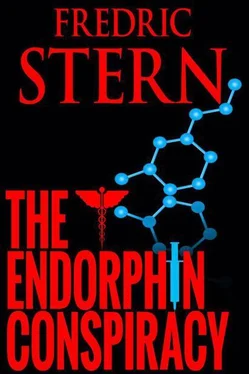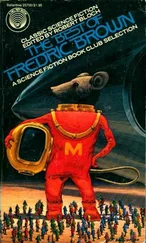Click-click. The brilliantly colored patterns dissolved, and a new image emerged, a large central blotch of orange-red, the brainstem, a more primitive area of the brain, responsible for controlling bodily functions, breathing and heart rate. Click-click-click. The central image magnified, honed in on the reticular formation, the gatekeeper of the brain’s conscious awareness, burning red on the CRT, its neuronal endings saturated with beta-endorphins.
“Well, that explains his coma,” said Geoff, pointing out the high concentration of endorphin receptors in the patient’s reticular formation. “Can you quantify it?”
Balassi answered the question with a click, positioning the cross hairs on the center of the hot spot on the screen by manipulating the mouse. Numbers appeared above the image corresponding to the color-hue scale at the top of the screen. Blue areas contained the smallest concentration of receptors, red the largest.
“Fifty picomoles per gram, about two-and-a-half times the normal density of endorphin receptors,” Balassi said matter-of-factly.
“That places him somewhere in the middle on the endorphin coma scale, about a three out of five, I’d say. Prognosis for coming out of his coma, fair,” Geoff said.
Balassi nodded affirmatively, manipulating the mouse and reducing the image magnification to review the slices higher in the brain at the level of the temporal lobe.
“What do those hot spots correspond to?” Karen asked, pointing to two faintly red, almond-shaped islands in a sea of chartreuse surrounding the central red of the brainstem.
“The amygdala, the area of the brain thought to be responsible for rage and fear. It probably contains the highest concentration of endorphins in the brain of a normal subject. But as you can see in our comatose patient, it seems faint relative to the sky high endorphin levels in his reticular formation, the endorphins suppressing his consciousness much the way a drug addict overdosed on morphine or heroine would be comatose. Morphine, heroine, and most narcotics bind to pretty much the same endorphin receptors, except, interestingly, PCP or angel dust, which binds to a class of newly discovered sigma endorphin receptors,” Geoff said.
“And the yellow-green area surrounding the amygdala? That indicates a moderate level of endorphin activity?”
“You’re catching on, Karen.” Geoff smiled. “That area is the limbic region, seat of our moods and emotions. The shrinks love to talk about this part of the brain. His limbic endorphin level appears normal. Good thing. The last thing you’d want out on the street is a schizophrenic cop.
“I’ll try and dig up a recent scan of one of the psych patients. The pattern’s completely different. The limbic area glows like a forest fire, and the reticular formation is blue as the ocean, just the opposite of what we see here. Looks kind of like a bright red horseshoe. Once you’ve seen the pattern, you won’t forget it,” Balassi said.
Geoff hadn’t been able to get that horseshoe out of his mind. He had to check for Romero’s scan before he left neuroimaging.
“Easy for you to say. Could just as well be psychedelic photos of the Beatles on the cover of Life to me. It all looks so foreign,” Karen said, shaking her head.
“Interesting scan, Geoff. Good case,” said Balassi. He turned to face Geoff. “Be sure to let me know how he does clinically so we can correlate the PET findings. Let’s be sure we keep within the project’s protocol.”
“Will do,” Geoff said. “You said you wanted to review the scan on the girl. There’s another scan I wanted to check for, also, a patient we scanned several months ago.”
Balassi raised his brow. “Oh?”
“His name is Jesus Romero. Ironically, he’s the crazy guy who held the girl hostage at the zoo. I tried to pull his scan up on the Neurad system from a terminal in the NSICU, but the system couldn’t find his record.”
“Why the interest in this Romero, Geoff?”
“Academic interest. That’s all.”
Balassi stroked his beard, hit the intercom button. “Walter, we need your assistance here.”
Seconds later, Walter Krenholz entered the control room. “Yes, Dr. Balassi,” he said, his face an expressionless mask.
“I need you to check the file room for two PET scans. One on Jessica Humphries, the other on a fellow named Romero, Jessie Romero.”
“Jesus is the first name,” said Geoff.
“Sorry. Jesus Romero.”
Bald as a cue ball, Walter’s deep-set, blue eyes appeared deeper still due to the dark circles below them. Sullen and seemingly devoid of personality, not many people at the NYTC, even those who worked directly with him day to day—as Geoff had for a year—knew much about Walter. Except of course, Balassi. The two had worked together for the last twenty years, Walter having accompanied him to the NYTC from the National Institutes of Health.
Walter nodded and left the control room.
“You know, Geoff, the Neurad system hasn’t crashed once yet. If it doesn’t show a scan on Romero, one was probably never done. You must be confusing him with someone else,” Balassi said. “But, if you like, I’ll try a search myself.”
Geoff shrugged his shoulders. “Sure.”
Balassi typed in a command to search for a scan on Jesus Romero. No image. No file. No such patient existed in the system. “Well, let’s see what Walter comes up with. If anyone can dig it up, he can.”
Their conversation was interrupted by Walter, who returned from the file room.
“I checked the files and the log books. There are no records of any scans on a Jesus Romero. The girl’s scan was signed out earlier today,” Walter said.
“Signed out?” Balassi asked. His face reddened, his gaze narrowed. “No one signs out a PET scan from here before I have a chance to review it! No one! Who signed that out?”
“Dr. Kapinsky,” said Walter.
“Who the hell does he think he is?” raged Balassi. His fist crashed down on the table, launching pencils into the air like aborted ballistic missiles. Walter scampered to pick them up and return them to their proper place.
“We have rules down here for a reason. If we let just anyone sign out an unread scan, they’d be all over this medical center! Besides, he doesn’t even know what he’s looking at.”
“Not that I’m defending his action, but we had a discussion about her scan on rounds this morning, and he probably wanted to review it himself. Maybe he’s becoming a believer,” said Geoff.
“Whatever the reason, his behavior is inexcusable. When you get up to the ICU, tell him I want that scan returned to me here—personally—or Pederson will hear about it!”
“I’ll take care of it,” Geoff said.
Balassi turned and headed out the door, leaving a gust of air in his wake. Walter Krenholz followed behind him.
Geoff was surprised by Balassi’s sudden outburst over the girl’s missing scan. It didn’t seem like a big deal to Geoff, but Balassi was a perfectionist. After a year in Balassi’s lab, Geoff was used to that side of him and knew how to handle his sporadic outbursts.
Geoff was more puzzled by the lack of a record of any kind on Romero. He was sure Romero had had a scan just months ago. Damn the Neurad system. He’d check the medical record file room himself.
A shrill, beeping tone pierced the air. The alarm stopped, and a voice boomed from the overhead speaker. “Code 999, seven east, code 999 seven east!”
Geoff startled, sprang from the chair. He looked up at the speaker on the ceiling, waited for the “all clear” signal. Must be a drill. The alarm resumed, followed again by the urgent page. “Code 999, seven east, code 999.”
“Shit. Let’s go, Karen!” He grabbed her arm, pulled her up from the chair.
Читать дальше












